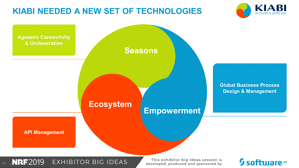How Kiabi Cleared its Digital Transformation Path
How French retailer Kiabi navigated its way through the digital transformation jungle with the help of Software AG.

Fashion business Kiabi is not dissimilar to many retailers in facing myriad challenges, but through its digital transformation it has built an underlying ecosystem, based on the sharing of data, into which its future global growth is now solidly plugged.
Speaking at Retail’s Big Show, organized by the NRF, in New York City, Christophe Alié, CIO and leader of innovation & transformation at Kiabi, acknowledged the company had been at a worrying turning point and he detailed how its partnership with Software AG had enabled it to transform its infrastructure.

“Digital transformation is a sort of jungle and we started on the journey through this jungle. I told the CEO [at Kiabi] what I’d like do but then when I sent the RFP (Request for Proposal) document out, the software vendors only seemed to care about the money,” he says.
The vendors put forward enormous projects while, in contrast, the proposal placed on the table by Software AG was initially a much smaller deal – with the intention that this could then be built upon over the course of a number of months and years. This was a much more agreeable approach to Kiabi, which was tackling three key challenges across its business.
Complexity across continents
First, it had the issue of operating across 500 stores located in 15 countries, as well as its online presence, which gave it the added complexity of handling the conflicting seasons whereby concurrently (it is the summer in the Northern Hemisphere and winter in the Southern Hemisphere). The challenges are around inventory management and controlling the order flow across these different zones.
Under the old system the process was very much batch-driven with orders taken across the whole rigid order management system. This could take around four hours for orders to move from their initiation to hitting the logistics platform.
The objective with the new platform was to be responsive and event-driven, enabling a more continuous flow of orders. The new business processes that have been drawn up drive operational procedures that then use API’s to orchestrate this activity.
The result? What was once a four hour process has been reduced down to a typical 30 minutes – for an average of 13,000 orders per day. The company can now scale with confidence from this new method, as shown by its painless handling of a record 35,000 orders on Black Friday. The old method led to the frequent missing of arranged time slots for deliveries that had to be set at 4-5 days, whereas this has now been reduced to 2-3 days.

Empowering the entire organization
Second, there was the issue of empowerment across the organization. Historically the France-based company had been able to initiate change across its domestic business in a relatively straightforward manner, but as the company grew globally it found it was tougher to share the processes across continents.
“In France we could just have a conversation and make the changes – it was in our minds – but it is tough to then take this abroad. As you go global you need to work out how to share the processes,” he explains.
To help address what Kiabi called its “process jungle” it introduced a “draw your job” initiative involving various teams around the world attending discovery workshops. There the objective was to draw their roles and to map these out into more streamlined processes compared with those in place. Not only did this make it a fun exercise but it enabled people to co-design their functions – in the context of the whole business – and validate the new processes.
Building an agile ecosystem
Third, there was the issue of the old infrastructure making it very difficult for the company to grow its sales globally through working with third-parties and business partners. With Software AG it had the opportunity to build an ecosystem that enabled the seamless sharing of data both internally and externally to these third parties. All the interfaces were designed to be exposed externally.
At the heart of this ecosystem is the management and leveraging of APIs. Kiabi’s cross-channel goal is ultimately being achieved through the implementation of an API-powered fast IT infrastructure, which enables its many partners to much more easily do business with the company.
“Suppliers can use our APIs to update their inventory figures and pricing and we have 99.86% availability [of APIs] across the platform,” says Alié, who says this includes APIs for styles, goods movement, product information, vouchers, factories and stores.
Underlying, crucial components
Underlying the transformation at Kiabi are some key components that comprise: the business process analysis, which was powered by ARIS; the integration and API management that is powered by webMethods; and the process orchestration that is also handled by webMethods.
This infrastructure with its API-based open architecture – with an agnostic view being taken on technology providers – has given Kiabi the ability to connect with any external solutions thereby giving the business a level of agility that will enable it to adapt to the inevitable changes that will occur in the market.
For more information about our Retail Insider and our guest blogger Glynn Davis, please go to his website here or contact him at glynn@busicomm.co.uk.
Find out how Software AG is helping the world’s most progressive retailers leverage technology to transform their business by clicking the Retail Transformation link below.